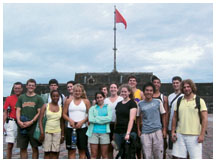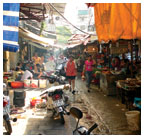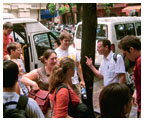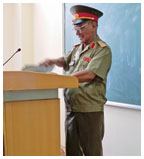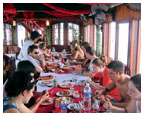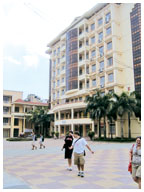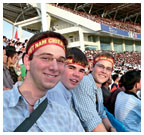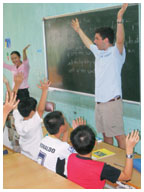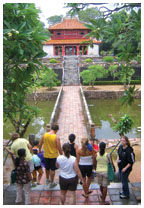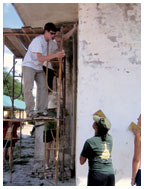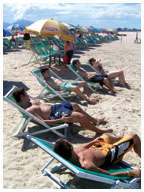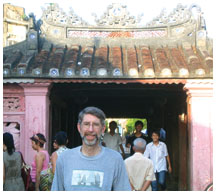
|
September 26, 2007: Features
In front of the flag tower at the Citadel in Hué are, back row, from left: seminar leader Desaix Anderson ’58, Mark Doramus ’09, Alexis Collatos ’08, Betsy Chisler ’08, Susan Lyon ’09, Tim Lanni ’09, Duane Hynes ’09, and Zach Ruchman ’10. Front row, from left: Kent Kuran ’08, Clelia Douyon ’10, Sonja Novak ’08, Janet Tambasco ’10, Deirdre Shannon ’10, National University of Hanoi student Nguyen Van Dzung, and Elias Hicks ’08. Missing from the photo is Adam Harris ’10. |
Good
morning, Vietnam
Undergrads get an intimate view of a war and a
former enemy
By W. Raymond Ollwerther ’71
Hanoi, Vietnam — It’s late morning on a sweltering Monday in July, and Lt. Gen. Nguyen Dinh Uoc is taking questions about the 1968 Tet offensive by communist forces in South Vietnam. It’s the second appearance by Uoc before the 14 Princeton undergraduates sitting in the small seventh-floor classroom at the National University of Hanoi. The white-haired former military leader wears a crisp khaki uniform, with two gold stars on each shoulder. Through headphones, the students listen intently to the translator sitting at the back of the room.
As the North Vietnamese planned the massive, coordinated assault on cities and towns throughout South Vietnam, what were their expectations in terms of a popular uprising? Had the Viet Cong’s heavy losses been anticipated? Why was the offensive launched over two days, instead of all at once? Uoc, who had participated in the siege of French troops at Dien Bien Phu in 1954 as well as the “American War,” strides over to a map of Vietnam to point out key locations in the southern part of the country.
Tet was a key event of the war — Uoc compares it to Dien Bien Phu in the struggle against the French — and the students have a keen interest in both the military realities and the popular perception of the uprising. At the midpoint of a six-week Princeton summer seminar on “America and Vietnam at War: Origins, Implications, and Consequences,” it’s a chance to seek clarification from someone with first-hand knowledge.
A Hanoi market, not far from the Princeton students' hotel.
Seminar leader Desaix Anderson ’58 (in light-colored shirt) reviews the schedule with students.
Gen. Nguyen Dinh Uoc recounts the “American War”.
Fresh-caught seafood is on the menu as the students take an overnight cruise on a junk in Halong Bay.
Princeton students outside the National University of Hanoi building where their classes were held.
Zach Ruchman ’10, Mark Doramus ’09, and Kent Kuran ’08 cheer on Vietnam at the soccer stadium.
Ruchman uses a children’s song to help a class learn English.
Visiting an elaborate royal mausoleum south of Hué.
Scraping and painting at a facility for Agent Orange victims.
Pausing at China Beach for some rest and relaxation. (Photos courtesy Zachary Ruchman ’10; W. Raymond Ollwerther ’71) |
The Princeton students are pioneers of a sort, taking part in the first global seminar offered through the Princeton Institute of International and Regional Studies (PIIRS) — part of the University’s recent push to give more students an international experience. Seven men and seven women, they have arrived here from homes across the United States, and with political views across the spectrum. Their majors range from anthropology to chemical engineering to the Woodrow Wilson School. They have come to study a war that divided America, recast U.S. foreign policy, and left an indelible mark on the generation that came of age in the 1960s and 1970s. But for this group, the war is history: The oldest of these students was born a decade after the war ended.
Sonja Novak ’08, whose parents emigrated from Czechoslovakia, came to experience a country under communist rule. Zach Ruchman ’10, who has taken part in an international conflict-resolution program for teens, was drawn to Vietnam because of its conflict and “recent rapprochement with the U.S.” Mark Doramus, a junior from Little Rock, Ark., felt it was important for his generation to study the Vietnam War. “The nature of the war, our successes and failures, apply to our country’s situation today,” he says.
Leading the seminar is a Princetonian who draws on experience and contacts in Vietnam that extend back four decades. Desaix Anderson ’58 served 30 years as a Foreign Service officer; he spent 18 months in Vietnam in 1965–66, traveling around the country for the Agency for International Development, and in later positions continued to be involved with Vietnam policy. After normalization of relations between the two countries in 1995, he was chosen to open the U.S. embassy in Hanoi. Charles Bailey *72, head of the Ford Foundation’s operations in Vietnam and Thailand, describes Anderson as the “pioneer of the new-era relationship.” Anderson says: “To launch reconciliation between America and Vietnam after 50 years of war and hostility was an extraordinary experience, the most intensely rewarding of my career.”
A soft-spoken native Mississippian whose careful speech still reflects a hint of a Southern drawl, Anderson studied literature, philosophy, and history at Princeton. He lives in Greenwich Village and Paris and is an accomplished painter, emphasizing themes that reflect his years in Asia. A PIIRS advisory board member, he conceived of the seminar in Vietnam.
Anderson’s involvement with the seminar is virtually non-stop, from tracking down a minivan that hasn’t arrived on time, to delivering an hour or more of lectures each day, to continuing strands of conversations with students late into the night. As the group walks across the plaza of the National University of Hanoi during the hottest part of the day, the 71-year-old seminar director typically is in the lead. “I have lots of energy,” he says. “I hear their minds working, and it’s rejuvenating to me.”
The program offers an intense mix of classes, community service, and constant immersion in Vietnamese culture. The students are staying in a small hotel in Hanoi’s Hoan Kiem District, named for the quiet lake at its heart and just south of the 36 Streets, the city’s historic commercial center in which each street originally represented a separate trade guild. A minibus picks up the group at about 8:20 each morning for the 25-minute ride across Hanoi, which retains many signs of a French colonial city, to a classroom at the National University of Hanoi. Though there are relatively few cars, the streets are filled with bicycles, taxis, buses, and most of all, thousands upon thousands of motorbikes. Traffic lanes are filled to capacity with riders; intersections are like the confluence of smaller tributaries flowing into larger streams, with the seemingly nonstop sounding of horns.
Inside the classroom in the eight-story glass and concrete social sciences building, the days begin with an hour learning the Vietnamese language. “Anh chi lam gi?” (“What do you do?”) Instruction is largely conversational, and proper pronunciation is essential. Vietnamese vowels use six tonal sounds, with diacritical marks noting changes in pitch. The result is that the same syllable can have as many as six different meanings, depending on how it is pronounced. Alexis Collatos ’08, who is majoring in the Woodrow Wilson School, tells how she spent 30 minutes practicing the phrase for “how are you?” with at least 15 city residents. The result? “About 30 percent recognized what I was saying,” she says. By the end of the seminar, the students are far from fluent, but can order a meal or tell a taxi driver their destination. “It gives them a better feel for the Vietnamese people,” Anderson says.
The heart of the class is 21/2 hours of lectures each day — as the students note, the seminar includes considerably more classroom time than the typical Princeton course (they will receive academic credit for a 300-level history course). Half the lectures are given by Anderson, who guides the students from the French Colonial period starting in 1848 up to the period of reconciliation between Vietnam and America.
The remaining lectures are offered by a dozen Vietnamese academics, authors, former military officials, and governmental representatives. “These people have really lived the history for the past 50 years,” Anderson says.
“To understand Vietnam, you need to know about the war.” It’s a Monday morning, and Bao Ninh, one of Vietnam’s most acclaimed writers, is at the podium. Ninh quickly sketches his background — he grew up in Hanoi, joined the army at 17 in 1969, fought in the south until 1975, when he was part of the liberation of Saigon, was released from the army and came to study “at this very university,” and started writing. “A simple life, actually — I wrote a novel and some short stories,” he says. Unmentioned are the favorable comparisons by Western reviewers of his 1991 book, The Sorrow of War, to All Quiet on the Western Front as a classic narrative of war. Ninh’s book, 233 pages of vivid imagery and harrowing tales of the devastation of war, has been praised for humanizing the North Vietnamese soldiers, who often were regarded in other countries as dehumanized fighting machines. The book was briefly banned after its initial release, and for years it was sold in Vietnam under the name The Destiny of Love. It is required reading for the seminar.
“We should never settle anything with a war, whatever the price. That’s what I really thought of when I wrote the book,” Ninh says in response to a question about his decision to become an author. He tells how the thinking was different when he was young — that then, to settle the big issues, the country had to fight. Ninh explains that he wrote the book to retell his war experiences to his friends and relatives. “So many veterans wanted to say similar things — that war could not solve anything — so Vietnam would believe and would consider peace to be something really grand. I wanted to contribute something, to have some voice.”
Ninh has visited the United States twice, the first time at the invitation of American veterans of the Vietnam War. “When I got their invitation, the war was really far away ... a lot of complicated feelings and emotions, difficult to describe,” he says. “When I was 17 years old, Americans were a matter of life and death — one dies, the other lives.”
Ninh was one of 500 young soldiers who went off to war with the Glorious 27th Youth Brigade in 1969. By war’s end, only 10 survived. The experience was not dissimilar from that of Kien, the central character of The Sorrow of War, who is the only survivor of his brigade after 10 years of fighting. “I was really scared, scared to fight with the Americans; I thought I would die,” Ninh says. “American soldiers — they had strength. ... I had a feeling that just a slap, and everything would disappear — nothing left, smashed to pieces.” But the North Vietnamese soldiers believed they would prevail, he says, and in time “we could see the weakening of the American troops.” As Ninh speaks, the students listen closely to every word from the translator. Ninh’s talk, Novak says afterward, was worth the cost of the seminar by itself.
While Ninh is received sympathetically, the students have pointed questions for several of the Vietnamese government officials who address them. The country’s ruling Communist Party continues to draw criticism for human-rights abuses, especially in the case of dissidents who support alternatives to the party, and the students press some of the speakers about religious and political freedom. When Gen. Uoc tells the students that American POWs were “treated very well,” the students don’t challenge him directly, but later, they dismiss his statement as propaganda.
Not all the education takes place in the classroom. One weekend, the group flies to central Vietnam for overnight stays in Hoi An, a small 17th-century port city known for its small shops and galleries, and Hué, where the students tour the ancient imperial city and take a “dragon boat” ride down the scenic Perfume River. Like Hué, which was taken over by communist forces during the Tet offensive and recaptured by U.S. troops after a bloody, 26-day battle, other parts of this trip have a special resonance for the students. They stop for a swim at China Beach, a military retreat for American soldiers during the war and now a white-sand beach with rows of inviting canvas beach chairs. Later they pass by the former military base at Danang, where the first U.S. ground troops landed in 1965 to secure the airfield; it’s now the site of rusting fuel tanks and crumbling concrete foundations.
Another weekend trip takes the students to a small rural village called Lao-ho, about an hour and a half northeast of Hanoi. The group first meets with three families suffering severe health problems attributed to exposure to Agent Orange, an herbicide sprayed in large quantities by U.S. troops during the war. The chemicals carried varying levels of dioxin, which is highly toxic to humans, and Agent Orange is viewed as the most difficult legacy issue of the war. This is one of many times during the seminar that the students appreciate the issue in human terms; later, they will discuss the problem — and attempts to remedy it — with Bailey, who has supported Agent Orange research studies at the Ford Foundation. After meeting the families, the students join a group of Vietnamese university students and move piles of dirt and bricks under a blazing sun to add shoulders to a single-lane road. That night, the students attend the village’s annual festival, featuring traditional Vietnamese songs and dance. The Princeton students, encouraged to join in the celebration, offer a rendition of “Old Nassau” that is warmly received.
“This was one of the biggest parts of the trip for me,” says Tim Lanni ’09, a history major. “I felt like we really made a connection with the people.” Lanni, a 6-foot-2-inch, 225-pound shot putter on the Princeton track team, is treated as a celebrity by the children of the village, who line up to have their photos taken with him. The University of Hanoi Web site later posts a story and photos of Lanni and his new friends with the headline: “TIMOTHY LANNI — American giant loves children.” The Vietnamese professor who arranged the project cites the “immense admiration for the Princeton students. ... They have enhanced the image of both Princeton and America enormously through their participation in this community service.”
On another hot afternoon, five of the seminar participants teach English in a five-story concrete building at the Cultural Palace. Ruchman stands at the chalkboard in front of 20 young children, using the song “The Itsy Bitsy Spider” as a teaching tool. After he writes the words out on the board, the children — enrolled in a government-supported summer program to improve their English-speaking skills — sing it along with him. He adds hand gestures to each line, and the kids energetically join in, though the words come out sounding more like “The Itchy Bitchy Spider.” “That sounded great, you guys!” Ruchman exclaims. Next, Ruchman selects a word from the children’s workbook and begins a game of Hangman, another favorite of the young students.
About seven miles west of Hanoi, the other students are scraping off peeling, mildewed paint and repainting a one-story concrete building at the Vietnam Friendship Village. The village is a small community that provides care for veterans and children who are believed by Vietnamese medical authorities to suffer from health problems linked to Agent Orange. The Vietnamese government estimates that hundreds of thousands of its citizens either were sprayed directly or inherited health problems tied to the use of dioxin. Though the American government takes the position that no scientific studies have established a direct link between Agent Orange and the disabilities, it has begun to address environmental contamination at sites on former U.S. bases in Vietnam where dioxin was stored. The Friendship Village, created in the early 1990s with support from veterans around the world, offers medical treatment and instruction in skills like artificial flower-making and sewing children’s clothes. In one room, more than a dozen children are doing embroidery, creating pastoral scenes or floral patterns that will be framed for sale. For Clelia Douyon, a sophomore from Florida, the service projects were an important factor in her decision to sign up for the seminar. “There’s something about international community service that really interested me,” she says. The chance to work with those believed to be victims of the war “is more applicable to what we’re studying,” she says.
Despite the legacy of war, the students are struck by the friendliness of the Vietnamese people. Nguyen Van Dzung, one of three Vietnamese students invited to join the Princetonians for their classroom instruction and travels, offers tips on local nightlife and restaurants and invites the entire class to his home for dinner with his family. Doramus notes how, as the students were visiting the Temple of Literature, Hanoi’s largest temple, “a guy our age came up, with no other motive than to talk to us, to see what we were doing. This has happened several times — there’s no anti-American sentiment here at all, which you would expect after the war.”
Several students stop by the American Chamber of Commerce’s annual Independence Day celebration, which attracts more than 200 Americans and Vietnamese who deal regularly with them. The country’s move toward a market economy has spurred rapid economic growth, and America is Vietnam’s largest trading partner. The celebration features a circus performance, jazz, a handler of very large snakes, activities for kids, some short speeches, a band playing classics of rock music, and lots of fried chicken, hot dogs, watermelon, and chocolate-chip cookies. It’s an interesting backdrop for Anderson and some students to continue a class discussion about antiwar protests (didn’t they undermine the war effort?), the draft (if there were one now, students would be leading opposition to the war in Iraq), media coverage of the war (was initial coverage of the Tet offensive intentionally biased?), patriotism (if the government makes a policy decision, isn’t it a citizen’s duty to carry it out?), and the best way for an individual to make the world a better place (find a good job and work for change). The music is loud, and the walls are topped with hundreds of red, white, and blue balloons. This is one of the few countries in the world, observes Kent Kuran ’08, where the United States could hold an outdoor patriotic celebration so openly without attracting anti-American protesters.
It is only in the last class session that the students compare in detail America’s wars in Vietnam and Iraq. For the previous five weeks, classroom discussion has focused on the war fought a generation ago, though the Iraq war surfaces on occasion: A session by Anderson about the lives of American GIs in Vietnam led to a discussion by the students of the pros and cons of having a draft or some other form of universal national service today. But in general, Iraq hangs in the air, as Kuran, a Woodrow Wilson School major, writes in a blog entry that he titles “The I-Word.” Some students, Kuran ventures, may think that exploring parallels between the two wars is “tacky,” or that “there is something callous about evoking the hopelessness and trauma” of Vietnam. Some, including Kuran himself, think the comparison would be a cheap shot against U.S. efforts in Iraq. “There is a strong desire to pretend that this conflict is different, that it’s not quite like the Vietnam story,” Kuran writes. “But there are no history books to tell us how Iraq ends.”
Ultimately, however, the students take the topic on directly, working with Anderson to come up with parallels in how the two wars began and were pursued. Some students say that in both cases, the United States became bogged down in war because it had little knowledge of its opponents’ culture or attitudes. Some see common traits among the South Vietnamese and Iraqi leaders, especially when compared to “the indomitable determination of Ho Chi Minh and his followers,” as Anderson recounts in a group blog compiled by many of the seminar participants. In both South Vietnam and Iraq, Anderson says, the students see “weak leaders that cannot motivate their disparate communities and people to come together in common cause.” The broader lessons of the Vietnam experience deal with America’s place in a world that is rapidly being transformed, he says — the need to promote U.S. interests while recognizing the perspectives of more than 6 billion non-Americans: “To lead in this emerging world we must understand others’ points of view and learn to reach mutually acceptable goals.” Anderson believes that the students, in exploring the causes and the consequences of the Vietnam War, have come to grips with its lessons.
Though many of the students comment on the patriotism of the Vietnamese — their evident love and support for the country even while they welcome their former enemies — this discovery is especially potent for Duane Hynes ’09, whose grandfather served in the South Vietnamese army and escaped with his family by boat on April 30, 1975, the day Saigon fell to the communists.
Hynes had arrived in Vietnam with a deeply personal view of the North Vietnamese: “hatred and anger,” much like his grandfather felt toward the people and the communist government, he believed. “They had basically taken away everything that my mother’s family had — their home, their jobs, their way of life,” he says in the end-of-course paper required of each student in the seminar. But Hynes says that he found the Vietnamese people to be courteous and friendly, “not at all like I had perceived. ... I felt guilty yet very much at home as I began to experience more and more of the culture.” His aunt, who lives in Hanoi, told Hynes that his grandfather loved the Vietnamese people deeply, though he hated the system under which they lived.
It was a revelation, Hynes writes, to discover that his grandfather was first and foremost a Vietnam nationalist: “These were now my people, and I was now able to fully embrace the half of my cultural background that had been so rarely celebrated living in America.”
He had learned, he says, “what it means to be Vietnamese.”
![]()
W. Raymond Ollwerther ’71 is PAW’s managing editor.
(Courtesy W. Raymond Ollwerther ’71) |
Views from another generation
Hué, the ancient Vietnamese capital, overrun by communist forces during the 1968 Tet offensive and recaptured after one of the longest, bloodiest battles of the Vietnam War. Danang, where the first U.S. ground troops landed in 1965 to secure the airfield that would become a main entry and exit point for American troops. China Beach, where the long, curving white-sand beach offered R&R to thousands of American troops.
Visiting these locations with the Princeton seminar in Hanoi aroused a rush of images from war-related events I covered as a Prince reporter during those turbulent times a generation ago: mass gatherings in the Chapel and Jadwin Gym as the University voted to go on strike; students lining up to surrender their draft cards; hand-screened T-shirts with clenched fists and the words “On Strike”; the Institute for Defense Analyses shut down for five days by hundreds of protesters who camped out on the grounds.
For my generation, the war and its divisive consequences would be a central part of our college experience. And though decades have passed, the war has continued to evoke a sense of unfinished business.
Charles Bailey *72, the Ford Foundation’s project director for Vietnam and Thailand, offers an apt metaphor: For America, “the Vietnam War is kind of caught in its throat, and it can’t get it out.” Losing the war was a “profound shock,” seminar leader Desaix Anderson ’58 says. “Our eternal optimism was questioned, our domination of the world scene since World War II challenged.”
It is a surprise, then, to hear the Vietnamese people say, over and over, that they have put the war behind them. They have fought many wars for the sake of their country over hundreds of years; since the war with the Americans, they have fought two more. If they continued to hate their former enemies, they say, they would have few friends. And they want to build their economy through expanded trade and investment with American companies.
Wendy Kuran ’79 says she was stunned when she learned that her son, Kent Kuran ’08, wanted to attend the Hanoi seminar. The Vietnamese people must hate Americans, she thought, recalling her participation in protests against the war in junior high and high school.
Studying the war can be valuable for Kent, she says, because it had such an impact on the United States and its approach to international interventions, because her son may pursue a career related to foreign policy, and because it can lead to a better understanding of his parents’ generation and “what helped shape our political views.”
When she learned from Kent that the war is in the past for the people
of Vietnam, it had a big impact. “It really struck me,” she
says, “the possibility of healing, the sense of getting on with
it.” ![]()
By W.R.O.

